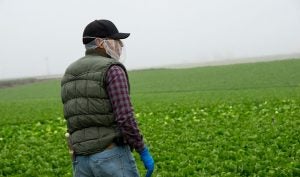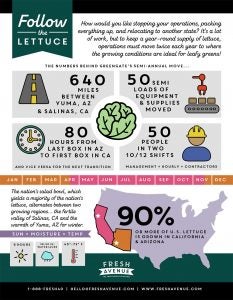When I was a kid, I had a bulletin board above my desk with all the mementos that were important to an 11-year-old. I distinctly remember two postcards from my dad that he sent to me when he was away for months before our family moved to another state. What I’ve come to find out in the produce industry, families move back and forth to California and Arizona or are separated during the winter growing season. These major moves happen not just once in a career, as the case for my family, but twice every single year.
This is what we call the transition; when the growing season for lettuce, spinach, and other tender greens shift from California for the spring and summer to Arizona for fall and winter. There is always buzz in the industry about the weather and what impact it will have on crops during this time. There is also the tactical and logistic challenges of disassembling and re-assembling an entire plant’s worth of equipment, loading it into tractor-trailers (which takes 50 loads), and moving it all 575 miles from one building to another. This is done with long yet rotating work shifts over an 80-hour window. But what about the families behind the plant operations that also make this move and how do they stay together when the wife, husband, mother, or father is following the lettuce?

In my last visit to Yuma, Arizona, I heard a few of the stories of these families and their dedication to the industry and their job, but more importantly to each other. The other spouse may have a non-produce job and need to stay in one location. The growing seasons don’t line up with school calendars so families with school-aged kids stay put while the parent in produce is away.
Richard Brown of GreenGate Fresh explained that technology makes things much easier then when he was raising his kids. He told me about the dad who would have dinner with his family each night with Skype and an iPad. They would even coordinate their menu so they were eating the same meal each night.
Richard Warsaw and his wife stay together throughout the year. They own a home in Salinas, California, and rent during the Yuma season. Julio McMahon, one of the warehouse managers at GreenGate, told me a little bit about how he and his family handles the long absence.
“While being away from family I personally keep busy due to not having my mind wonder off, prepping finances to physical isolation from family. I’m not bothered being away for so long simply because I am accustomed to the nomad lifestyle (prior service USMC) and I get to visit with family once a month. While working away from home, I get to focus on my job 100 percent without distractions and hone my skills within my department and overall with the company. My wife currently does not work and lives close to immediate family, so the children are well taken care of while I am away. I Facetime them, take pictures, keep up on social media, just to stay in contact with the kids. It is difficult, but like I mentioned before, my job keeps me plenty busy. Needless to say, it is a self-rewarding job.”

Those of us that buy lettuce at the grocery store or sit down at our favorite restaurant to eat a salad probably have not thought about what goes on behind the scenes to keep greens on our plate the entire year. As with any industry there is a lot that happens and goes unnoticed. As we start the move from winter growing in the Southwest desert up the California coast to the Monterrey bay area, remember all the moving pieces; weather, logistics, equipment, and the time crunch to not lose any production time. Most importantly, remember the families that also follow the lettuce.
Amber Parrow is the marketing director for Fresh Avenue, a group that represents produce farms and producers with national sales and marketing. You’ll find her with a camera in a romaine field or behind the computer promoting brands that promote quality, safe, and nutritious food.



